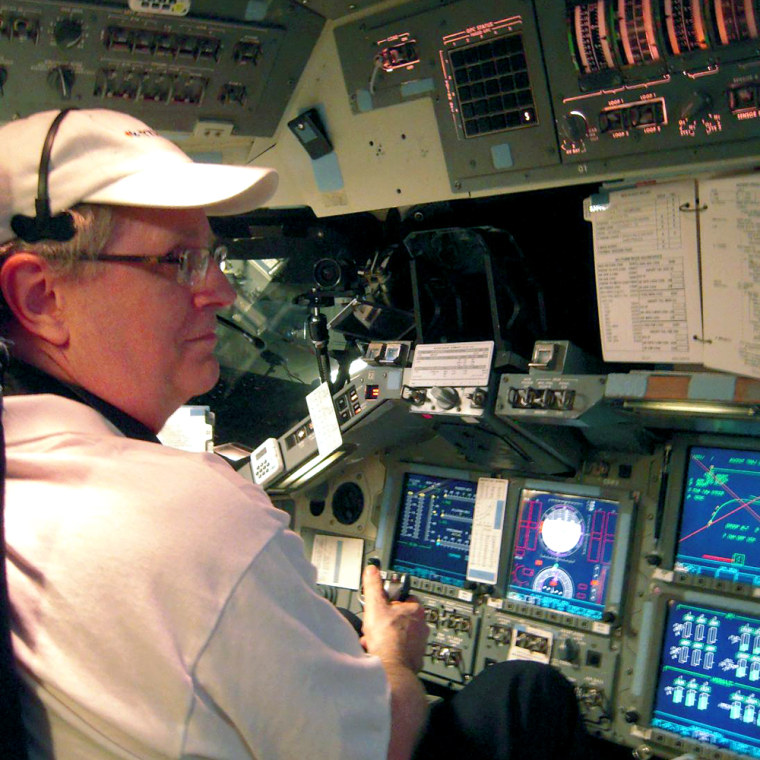After a decade of trying, I finally landed a space shuttle.
Not the real thing, of course. I'm talking about a simulated landing, basically flown on a computer. Every once in a while, I've tried my hand on the arcade-game-style shuttle simulators you might find at science centers and museums, and it hasn't been pretty. I'd come down to hard, or confuse my "up" and "down" on the joystick, or veer off the landing strip. I've gotten pretty used to flashing red lights and low scores over the years.
So when it came time to go up the stairs and climb into the motion-base shuttle simulator at NASA's Johnson Space Center, the first thing that came to mind was the Astronaut's Prayer: "Dear Lord, please don't let me screw up" (or something like that). The pressure got just a bit worse when our trainer for the session, NASA flight controller Corbett Hoenninger, told our crew of journalists that the folks who rode in the simulator just before us were the Atlantis astronauts themselves.
I climbed into the commander's seat for the initial takeoff. The motion-base simulator is a little bit like the ones you might find at high-class amusement rides — a mockup cockpit that's crammed with real-looking hardware, including a heads-up electronic display on the forward window and a 1980s-vintage seatbelt with five clip belts for the shoulders, waist and crotch.
As I gripped the joystick with my right hand, Hoenninger was reassuring.
"I have faith in you," he said.
"I don't," I answered.
First, we experienced launch. There was really nothing I needed to do, except to roll with the rocking simulator, listen to the recorded rumble and watch the solid-rocket boosters fall away on the computer-generated display out the side window. Then we went right to the landing sequence.
There are lots of gauges and rolling balls that the real astronauts can probably make sense out of, but for me, the key thing was to peer into the heads-up display and use the joystick to keep a small glowing diamond inside a bright circle on the heads-up display. The circle shifts around the screen, to reflect how you should be moving the joystick to make a banking turn and level up the gliding shuttle for final approach to the simulated runway.
I went through a little bit of that up-down problem, but Hoenninger was there to remind me of the difference — and alert me about two little triangles that would start rising up from the bottom of the video display. As the start of the runway grew larger on my display, the triangles served as a guide for moving the joystick so that you landed level instead of falling onto the runway like a brick. The latter alternative is something I'm all too familiar with.
Believe it or not, I actually set our virtual runway on the ground without crashing, although there was an inelegant thump and a screech that sounded off-nominal. Then Hoenninger reminded me about the pedals. The shuttle has two hydraulic pedals that control your wheel braking to keep you on the centerline as you slow the craft to a stop. The system couldn't be simpler, but it still took me a few seconds to get the coasting under control — in part because I let my feet slip off the pedals while I was flying.
After my landing, each of the other three journalists took their turn. All of us set the shuttle down successfully. In fact, Hoenninger told me later that not one of the visiting media types had crashed. That made me feel a little less special. But I did get a "Certificate of Accomplishment" for successfully landing the motion-base shuttle mission simulator, which I'll put in a place of honor in my office cubicle.
So now I can finally put my shuttle jinx to rest — and just in time, too. With the end of the shuttle program, the shuttle simulator is due to be disassembled and shipped off to Texas A&M, to be used by a new generation of aerospace engineers and virtual space jockeys. To those Aggies, I say: Godspeed ... and keep your feet on the pedals.
Connect with the Cosmic Log community by "liking" the log's Facebook page or following @b0yle on Twitter. You can also check out "The Case for Pluto," Alan's book about the controversial dwarf planet and the search for new worlds.
